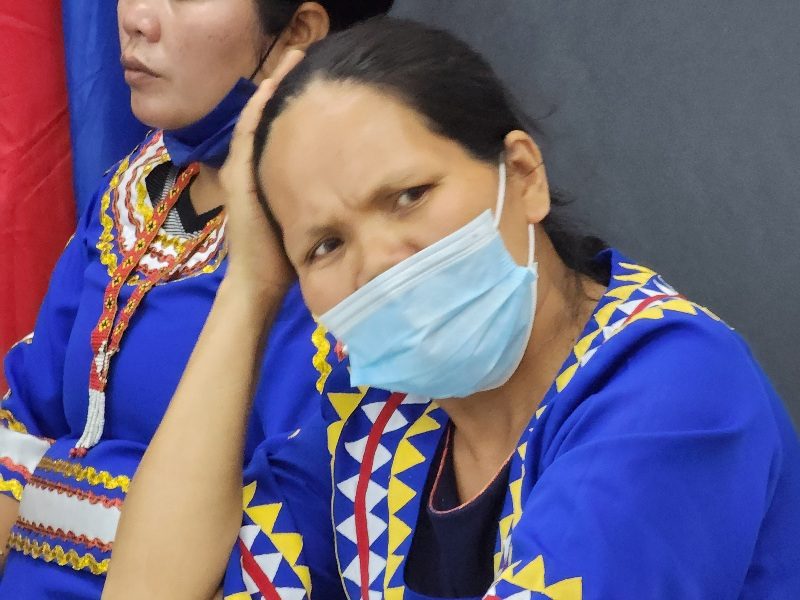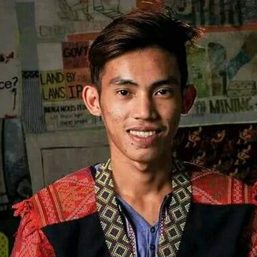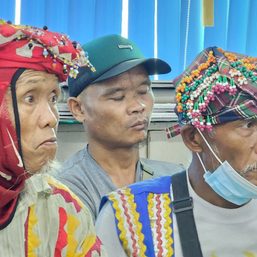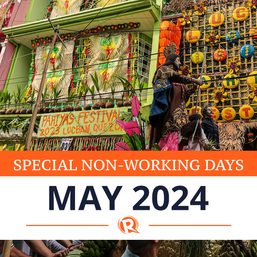SUMMARY
This is AI generated summarization, which may have errors. For context, always refer to the full article.

First of 2 parts
CAGAYAN DE ORO, Philippines – An old cultural tapestry weaves a compelling story of preservation in Misamis Oriental, where a Higaonon indigenous community, the custodian of one ancestral land, finds itself locked in a race against time to protect its cherished heritage.
As the sun sets over the horizon, casting a golden hue upon their ancestral land, lowlanders have begun to exploit the territory’s burgeoning growth and public infrastructure development.
The Higaonons stand at a critical juncture, and their only hope lies with a government that has yet to get its act together, is sluggish in addressing Lumad causes, and, at times, even acts as one of their oppressors.

For over a decade, the Mat-i, Man-ibay, Civoleg, and Langguyod Higaonon Tribal Community Incorporated (Mamacila) has been pleading with the National Commission on Indigenous Peoples (NCIP) to help them facilitate the registration of their ancestral domain territory in Misamis Oriental province.
Now, the opening of a new scenic and shorter route to the province’s easternmost parts has led to a surge in economic growth and a frenzied acquisition of land parcels within the Higaonon ancestral domain at the expense of Lumad families.
Investors raced to secure land rights, outpacing the Higaonons’ painstaking efforts to raise funds for their group travels to Cagayan de Oro to prod the NCIP to help them.

The land is theirs
The Higaonons’ right over the 17,558-hectare territory, stretching from Claveria town to Gingoog City in Misamis Oriental, was upheld by the NCIP en banc 14 years ago through Resolution No. 123-2009. It granted their petition for the identification, delineation, and recognition of their ancestral domain claim.
The NCIP gave them a Certificate of Ancestral Domain Title (CADT) on July 23, 2009, covering parts of the villages of Aposkahoy and Mat-i in Claveria town to Lunotan in Gingoog City.
An NCIP-issued CADT, which acknowledges the existence of an ancestral domain and legitimizes a claim over it, is a form of land tenure instrument that grants ownership rights and management authority to an indigenous community.
The document also serves as proof of a group’s indigenous rights for the protection and preservation of its cultural heritage, traditional practices, and natural resources within a territory.

Until it became the preferred route of travelers from Villanueva town near Cagayan de Oro to Gingoog City near the boundaries of the Northern Mindanao and Caraga regions, the area was known to offer more secure mountain paths for New People’s Army (NPA) rebels who crisscrossed Misamis Oriental’s villages.
Opened in 2014, the highway became popular for its scenic mountain views, fog, and cool temperatures. It also significantly reduced travel time between Cagayan de Oro and Gingoog by at least an hour.
Now popularly known as Route 955, the road reaches an elevation of nearly 1,200 meters above sea level at the 48-kilometer mark. Travelers along the route almost always encounter a refreshing climate characterized by rapid weather fluctuations, transitioning from sunny skies to cool winds and fog even at high noon. It quickly became a favored destination for people seeking respite from the urban heat.
Route 955, however, cuts across the Higaonon ancestral domain. With the development of the road came a tourism boom, resulting in the establishment of numerous mountain resorts, restaurants, and cafes, starting from Claveria town to Gingoog City.
Erlinda Malo-ay-Morga, the chairperson of Mamacila, the holder of the ancestral domain title, is worried that they might lose all the land inherited from their ancestors to land grabbers.
“For indigenous people like us, our lives are intertwined with the forests. Without the forests, there might be no IPs,” Morga told Rappler on June 5.
Going in circles
Years after obtaining the title from the NCIP, hundreds of Higaonon families from Claveria to Gingoog now face the imminent risk of displacement. Their failure to segregate and register their properties with the Land Registration Authority (LRA) has jeopardized their homes and their future.
The reason: even after 14 years, the Commission has yet to write a simple work and financial plan to assist the Higaonons with their segregation and registration process.
In the context of ancestral domains, segregation refers to the process of setting apart specific areas exclusively for the use of particular indigenous groups or communities.

They were informed that without such an NCIP plan, it would be difficult to even determine cost estimates.
“We have been going in circles for years,” complained Salvador Limbatao, a Higaonon from Gingoog City.
He said they were simply informed that the NCIP lacked the budget to support them with the legal processes.
“So, the reason why our land has not been registered all these years is because we have no money,” Limbatao said.
The Higaonons were also dismayed when NCIP officials requested Mamacila to provide them with copies of their previously submitted documents, supposedly because their papers were not among the NCIP’s files.
“Maybe there was inefficiency in the past. I really don’t know,” Jerie Ragsac, a relatively young lawyer who currently serves as the acting NCIP head for Misamis Oriental, told Rappler.
Ragsac promised to work on the Lumad’s concerns and assist them in processing their papers this time.
Chaos and losers
Discord and a lack of trust between the NCIP and DENR in Northern Mindanao affected the Higaonons. The Lumad community has been waiting for several years for the government to finalize the registration process of their ancestral domain.
“They (NCIP people) don’t trust us, and we don’t trust their processes, too,” said lawyer Ban Mikhael Pacuribot, DENR’s legal division chief in Northern Mindanao.
Accusing fingers were pointed at the DENR during the June 5 dialogue in Cagayan de Oro between the NCIP and Mamacila.
According to the Higaonons and an NCIP official, the DENR has been responsible for numerous land conversions within the Higaonon ancestral domain.
These conversions involve the reclassification or conversion of timberland or public domain into “alienable and disposable” land, enabling the land titling processes.

Marie Paulyn Superales, head of the NCIP’s local service center, said there have been multiple land conversions within the ancestral domain, with the DENR playing a central role.
“It is very easy to circumvent through the classification of land as alienable and disposable,” Superales told the Higaonons during the dialogue.
Barking up the wrong tree
Pacuribot, however, said the DENR has never converted any land in that area because only the President has the authority to do so.
He attributed the problem instead to the NCIP’s failure to provide the DENR with a map of the Claveria-Gingoog ancestral domain.
Without the necessary data and map from the NCIP, the DENR cannot determine which areas, declared alienable and disposable by the President, are covered by the 2009 CADT, Pacuribot told Rappler.
The most common DENR document encountered by the Higaonon group is the Community-Based Forest Management Agreement (CBFMA) given through a program that aims to promote sustainable forest management by involving local communities in the protection, conservation, and responsible use of forest resources.
Under this program, forest-dependent communities are granted access and management rights over specific areas, taking responsibility for the sustainable management of forest resources for 25 years.
“We have contracts with them (DENR beneficiaries). Then out of the blue, other groups would surface and make conflicting claims,” Pacuribot said.
2021 public land law
But Pacuribot said a two-year-old law, signed by then-president Rodrigo Duterte, allows citizens to seek free patents if they have occupied or cultivated tracts of alienable and disposable land for at least 20 years.
To qualify, an applicant must have paid real estate taxes and not own more than 12 hectares.
He or she also has to show proof that a tract of alienable and disposable public land has been continuously occupied and cultivated for at least two decades, based on the 2021 law, Republic Act No. 11573.
The law removed the December 31, 2020 deadline for free patent applications and reduced the required possession period for confirming imperfect titles to 20 years.
It tasked the community or provincial environment and natural resources offices (CENRO/PENRO) to process agricultural free patent applications within 120 days.
The 2021 law accelerated titling processes, and the Claveria-Gingoog area saw increased land survey work that same year.
Manuel Uy, advocacy officer of the Non-Timber Forest Products Exchange Programme-Philippines, a non-government organization helping the Higaonon community, said Mamacila reported frequent DENR land survey work in the CADT-covered ancestral domain in Claveria and Gingoog in 2021.
Uy said the DENR surveys were done during one of the worst periods of the COVID-19 pandemic that same year when Duterte approved the law that amended the country’s old public land and property registration laws. (To be concluded) – Rappler.com
NEXT: Part 2 | Misamis Oriental land rush threatens Higaonon ancestral domain
Add a comment
How does this make you feel?

























There are no comments yet. Add your comment to start the conversation.